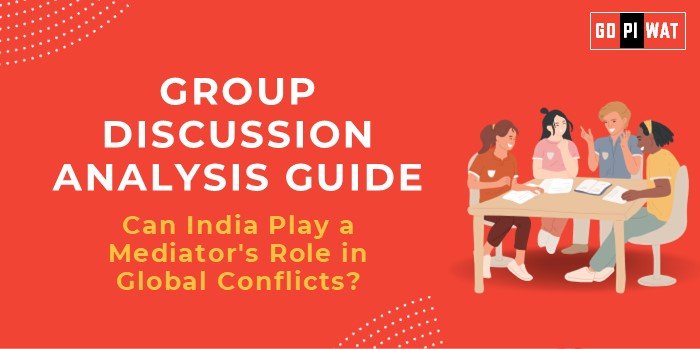📋 GD Analysis Guide: Can India Play a Mediator’s Role in Global Conflicts?
🌐 Introduction
Context: India, with its growing global stature and historic ethos of non-alignment, is increasingly seen as a potential mediator in international disputes.
Background: India’s non-alignment movement during the Cold War established its role as a neutral actor. In recent times, its strategic partnerships with both developed and developing nations enhance its credibility in addressing global conflicts, from the Russia-Ukraine war to Indo-Pacific tensions.
📊 Quick Facts and Key Statistics
- 🌍 India’s Trade Diplomacy: $813 billion in global trade (FY 2023) underpins its influence in economic diplomacy.
- 🕊️ UN Peacekeeping Missions: Over 200,000 troops contributed, making India a top contributor to peacekeeping forces.
- 📈 Global Mediator Rankings: Ranked as a favorable mediator in Asia-Pacific by international think tanks.
- 🤝 Strategic Alliances: Member of BRICS, Quad, and SCO, bridging diverse geopolitical interests.
🔗 Stakeholders and Their Roles
- 🏛️ Indian Government: Setting diplomatic tone via initiatives like G20 presidency.
- 🌐 United Nations: Leveraging India’s peacekeeping record.
- 🌍 Global Powers (e.g., USA, China): Engaging India as a neutral mediator due to its geopolitical balance.
- 🇳🇪 Neighboring Nations: Expecting India’s role in de-escalating regional conflicts like those in South Asia.
🏆 Achievements and Challenges
✨ Achievements
- 🤝 Successful mediations: Maldives’ political crisis (2018).
- 🌍 Neutral stance: During the Russia-Ukraine conflict, fostering dialogue with both sides.
- 💼 Strategic trade ties: Maintaining balance with conflicting nations.
⚠️ Challenges
- ⚔️ Balancing rival powers: Relations with the US and China.
- 🛑 Perception of bias: Regional disputes in South Asia may hinder credibility.
🌍 Global Comparisons
- 🇫🇮 Finland: Mediatory success in Middle Eastern conflicts.
- 🇹🇷 Turkey: Role in negotiating the Black Sea Grain Initiative.
📚 Structured Arguments for Discussion
- Supporting Stance: “India’s historic neutrality and strategic autonomy make it an ideal mediator in complex disputes.”
- Opposing Stance: “India’s unresolved border issues (e.g., with China and Pakistan) limit its perceived neutrality.”
- Balanced Perspective: “While India has credibility, its regional disputes may need resolution to boost its global mediator status.”
💡 Effective Discussion Approaches
✨ Opening Approaches
- Highlight India’s G20 presidency role in bridging East-West tensions.
- Start with India’s peacekeeping contributions to the UN.
📌 Counter-Argument Handling
- 🌍 Acknowledge criticisms of regional bias but emphasize its balanced international engagements.
📈 Strategic Analysis of Strengths and Weaknesses
- 💪 Strengths: History of neutrality, economic ties across regions.
- 🛑 Weaknesses: Perceived bias in regional conflicts, lack of major mediatory success in global crises.
- 🌟 Opportunities: Utilize its G20 platform to assert leadership.
- ⚠️ Threats: Geopolitical tensions could hinder neutrality.
🎓 Connecting with B-School Applications
📚 Real-World Applications
Use cases in international business negotiations and conflict resolution.
🤔 Sample Interview Questions
- “How can India’s mediation efforts align with its economic ambitions?”
- “Compare India’s mediatory potential with global leaders like Turkey or Finland.”
✨ Insights for B-School Students
- Strategic negotiations, balancing stakeholder interests, leveraging economic power in diplomacy.


